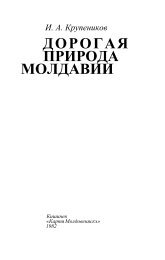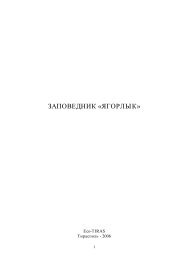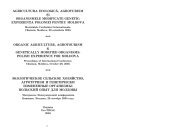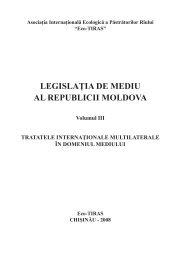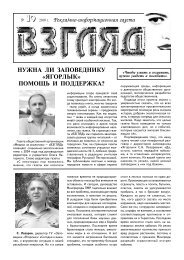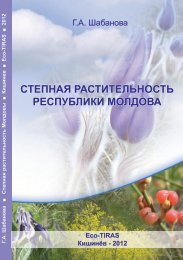ENVIRONMENTAL MANAGEMENT OF NATURAL RESOURCESR.M. CorobovThe independent researcher, Chisinau, MoldovaУстойчивый менеджмент окружающей среды имеет общие черты с другими секторами общественного управления, особенно стеми, что управляют общими ресурсами. Сложность идентификации реальных проблем окружающей среды обусловлена теснотойсвязи между социальными системами, охватывающими многочисленных субъектов действия, и природными системами (ресурсами).Обсуждаются методологические подходы управления природными ресурсами в определенных институционных рамках и через определенныйинституционный режим.Environmental management has similarities with othersectors of public planning, especially those managing acommon resource. The absence of adequate prices, themultitude of claims to scarce resources and the complexityof environmental problems are similar to the problemsencountered in developmental decision-making. Thus,tools used in the development planning can be suitablyadapted to incorporate environmental effects into thedecision-making and planning process (Noorbakhsh andRanjan, 1999).In setting the real environmental problems, a complexityderives from the interactions between the humansystems, comprising numerous actors and activities,and the natural systems (resources) that are mediatedby interacting resource regimes (Briassoulis, 2004). It iswidely accepted that management of natural resourcesshould aim to benefit all resource users, as equitably aspossible, within the constraint of environmental, financial,institutional, and so on sustainability (Cain et al., 1999).However, in practice, the policies of natural resourcemanagement are not working very well, and currentpatterns and levels of their use are not sustainable.Applying the seemingly “best practices” too often leadsto unintended and unwanted outcomes, and hundreds ofdiverse socio-ecological systems have failed to achievetheir goals with resulting social disruption and a decline inthe resource base (Millennium Assessment, 2005).Walker (2006) explains this situation by the factthat in most cases, even when intentions are good, anddifferent objective local or national factors are neglected,the inappropriate resource use policies and managementactivities stem from inappropriate ‘mental models’. Peopleuse and modify nature, proceeding from their notions ofhow human systems and nature work. These mentalmodels, or paradigms, often either ignore or simplifyinappropriately the vital aspects of the ways in which realworld systems work actually. The ruling mental modelsfor resource use and development, still based on thedeterministic ‘command-and-control philosophy’ that viewsthe natural systems as highly controllable, mark the earlyapproaches to natural resource management. Prevalenceof these models over the world can be explained by fourflawed assumptions (Walker, 2006):– A focus on average conditions, rather than onextreme events, the fixed and short-time frames andfixed spatial scales, rather than multiple nested scales;– A belief that problems from different sectors do notinteract in the systems, while interacting sectors are akey feature of systems’ dynamics;– An expectation that change will be incrementaland linear, when it is frequently non-linear and oftenlurching;– An assumption that getting the system into, andthen keeping it in, some particular state will maximiseyield from the resource base, is indefinitely. It is anunattainable goal, and there is no sustainable “optimal”state – be it an ecosystem, a social system, or the world.Walker (2006, p. 79) concluded that “Partial solutionsto problems in complex social-ecological systems do notwork for very long”, and proposed an alternative approachassuming that social-ecological systems behave ascomplex adaptive systems with alternate attractors,or alternate system regimes. Three attributes of thesesystems – resilience, adaptability and transformability– determine the topology of the system’s stability and,therefore, the likelihood of regime shifts. Governance andmanagement of resilience is therefore concerned withlearning how to avoid (or to cross) thresholds betweenalternate regimes and how to influence the positions ofthe thresholds.“Management of natural resources is generallyachieved by a combination of experience, intuition, trial,error and effort. This may be successful but is not a basisfor effective long-term resource management systems,which are essential to improved management practice”,– stated Cain et al (1999, p. <strong>13</strong>2). Experience has shownthat a multi-objective management approach, termedIntegrated Natural Resource Management (Batchelor,1995), is needed and that it should, ideally, comprisesthree components:– the formulation of management strategies;– the implementation of the strategies and monitoringprocedures to assess whether the impacts are thoseintended;– the corresponding adaptation of the strategies.It is also necessary to keep in mind that resourcemanagement operates in the stochastic environment. Inthe interpretation of Batabyal and Beladi (2006) this meansthat state of a managed resource at any particular point intime is a function not only of the actions undertaken by amanager, but also of unpredictable environmental factorslike droughts, fires, or predators. As a result, even if amanager believes that taken actions ensure that a resourcedoes not hit any of the crisis states, it may still do so.The use of threatened natural resources can beinfluenced and managed within a certain InstitutionalFramework or through Institutional Resource Regime.Varone et al. (2002, p. 78) understand theInstitutional Resource Regime. as “… a combinationof formal property (ownership), disposition and userights, and the prominent elements of resource-specificprotection and exploitation policies the design of whichcomprises specific aims with respect to preservationand use, the intervention instruments, institutional actorarrangements, etc”. The ‘disposition rights’ are consideredas the possibility for a formal owner to freely ‘dispose’the resource or its part, for example, to sell, to give, torent, and so on. Disposition rights refer also to the rightto transfer specific use rights or to sell the resource itselfversus existent distinguishing “the rights to own and the— 109 —
ight to use”. Varone et al. (2002) made also a distinctionbetween the resource stock and resource fruit (or yield).When one refers to a natural resource management bothstock and yield are intended.According to Briassoulis (2004), resource regimesare also historically and socio-culturally determined.Consequently, they include only selection of a resource’aspects and attributes with respect to particular activities.In addition to formal ownership and use rights, resourcerights may be informally agreed by a local community of resourceusers and enshrined in community norms and rulesof resource use. The spatial and temporal variability anddiffering degrees of spatial fixity of resources and crucialconstraints for the sustainable development of human activities,produce diverse resource regimes at various levelsof socio-spatial organization within different time frames.To address the institutional aspects of natural recoursemanagement, Briassoulis (2004) proposed tocombine the ideas from the interrelated paradigms of thetheory of complexity with a new institutional approach tosocial and planning analysis that places emphasis on actors(individuals and groups), the diverse relational websor networks to which they belong, the stakes they have inlocal environments and the practices they follow to pursuetheir interests. It asserts that individual identities are sociallyconstructed within settings structured by the powerfulforces—socioeconomic and political organizations, socialdynamics, nature—where power relations shape theopportunity space and value systems of human agents.The actors, as reflective beings, are not passively shapedby and devise actively their social situation, interactingamong themselves and with environment and developingrelational bonds of various strengths and reach.Proceeding from this preconditions, Briassoulis(2004) presented the methodological framework for analyzingthe interactions between ‘problem setting’ and ‘institutionalsetting’ at each principal stages of a policy andplanning process (problem definition, policy/plan formulation,evaluation and implementation). Fig. 1 shows howthese interactions produce complexity in identifying sustainablesolutions to environmental problems, the effectsof this complexity and its implications for planning/policyeffectiveness. The proposed framework was developedfor the analysis of desertification control in MediterraneanEurope. However, some conceptual comments of the author,which we decided to present shortly below, are ofinterest for discussing the problem on the whole.In this framework the Problem setting comprises currentand potential activities, resources and requirementsin them by each activity. The Institutional setting comprisesformal and informal actors and resource regimes.The stages of Policy and planning process in Fig. 1 areshown hierarchically and sequentially arranged, in realitythey intermingle and interact through continuous feedback.In more details, these stages can be described as follows.Problem definition. Any environmental problem istypically first defined by those actors who have stakesin particular activities. Consequently, only the resourcesystems of immediate importance to these activities areemphasized; lesser or no attention is paid to the othersthat may be directly and importantly related to the first.Several uses of resources may also be excluded fromoriginal definition of the problem, and thus are sidelinedin a subsequent policy and planning analysis. Activitieshave different qualitative and quantitative resource requirementsthat are environmentally and socio-culturallydetermined. Depending on who defines the problem, particularphysico-chemical attributes as well as functionsand dimensions (environmental, economic, or social) ofthe considered resources are underscored. When severalactivities compete for the same resource, the pressuresand conflicts over resources increase. Generally, “…problemdefinitions are activity-led, characterized by particularactivity-resource combinations that reflect both the interestsof those defining them and the broader historic contextand socio-cultural milieu” (Briassoulis, 2004, p. 120).The governance system determines who participatesin problem definition. In centralized systems, the problemsare usually defined ‘top-down’ and are thus typically moreexclusive in who contributes; in decentralized systems, aproblem definition may be a more participatory process.The perception of the problem by those with the ‘a rightto define the problem’ influences their active participationand emphasis placed on certain attributes of the resourcesconsidered. In addition to formal stakeholders, a hostof the informal ones also indirectly influence a problemdefinition.Stakeholders, which have different socio-economicprofiles, goals, interests, future outlooks and preferencesfor particular activities, occupy different positions in diverserelational webs and possess different power to promote,or even impose, their favored definition. They espousedifferent causal theories about the problem and influencethe choice of activities, resources and their characteristics,activity-resource relationships and spatio-temporalframes of reference that are considered. Their theoriesare also influenced by the current state of knowledge andavailability of data that can be also incomplete, missing,or even contradictory. Because environmental resourcesoften cross administrative boundaries and spatial levelswith different regimes governing and use, as well as withdifferent resource interests, an institutional interplay arises.Interests and resource regimes from various levelsinfluence problem definitions at a certain spatial level.Multiple, frequently conflicting definitions of a problemexist usually when the most powerful interests dominate allothers and drive the choice of a problem-solving approach.The problem definition that guides the policy and plan formulationstage is an ‘emergent’ definition in the sense thatit is not the sum of the definitions of those experiencing theproblem but is the result of their synthesis at some higherlevel. The resource-wise problems may be ill-defined becausean uneven emphasis on resources, their attributesand their horizontal and vertical interrelationships, dependingon which the activities compete for resources. Thepresent and future causal structure of the problems usuallyremains vague and unclear, at least at the spatial level(s) atwhich they are defined. The complexity of the institutionalsetting results in the spatial and functional compartmentalizationof the environmental integrity of resource systemsat the problem definition stage. Undoubtedly, this cannotsupport holistic resource management: partial, biased,incomplete, competing and exclusionary definitions affectaccordingly the solutions proposed and the priorities assignedto policy and planning actions.Policy/Plan Formulation. At the formulation stage,the additional concerns arise because of the mix of actorsinvolved: the ‘old’ (those who defined the problem)and the ‘new’ (those officially charged with policy and planformulation). The differing traits, competencies, power re-— 110 —
- Page 3 and 4:
Descrierea CIP a Camerei Nationale
- Page 5 and 6:
Уважаемые коллеги,
- Page 7 and 8:
щегосударственной
- Page 9 and 10:
доме, в котором мы в
- Page 11 and 12:
шие глубины на заде
- Page 13 and 14:
с малыми восстанов
- Page 15 and 16:
Литература1. Жадин
- Page 17 and 18:
Рис. 3. Многолетняя
- Page 19 and 20:
тера и глубины изме
- Page 21 and 22:
ПОДДЕРЖАНИЕ БИОРАЗ
- Page 23 and 24:
Таблица 5. Оптималь
- Page 25 and 26:
Таблица. Результат
- Page 27 and 28:
ФОРМИРОВАНИЕ БИОЦЕ
- Page 29 and 30:
Подавляющее больши
- Page 31 and 32:
Рис.1. Днестр вблизи
- Page 33 and 34:
сопоставимости дан
- Page 35 and 36:
ции с международны
- Page 37 and 38:
А.Н. Бургеля, К.П. Бу
- Page 39 and 40:
Выводы1. Уже на само
- Page 41 and 42:
тегории, виды и пор
- Page 43 and 44:
санитарно-эпидемио
- Page 45 and 46:
Таблица 4. Распреде
- Page 47 and 48:
реационных, монито
- Page 49 and 50:
Шабановой Г.А. и Кух
- Page 51 and 52:
могут быть убраны,
- Page 53 and 54:
Турунчук. Связь с с
- Page 55 and 56:
Праздник «День Рек
- Page 57 and 58:
500ЈPРис. Распределе
- Page 59 and 60: Н. Гроссу * , Р. Шакир
- Page 61 and 62: Рис.1. Помесячное ра
- Page 63 and 64: Calitatea apei r. Nistru conform gr
- Page 65 and 66: Карта геохимическо
- Page 67 and 68: лесу был дуб, сегод
- Page 69 and 70: При предварительно
- Page 71 and 72: щих улучшить социа
- Page 73 and 74: ней опасных загряз
- Page 75 and 76: ФотоприложениеФот
- Page 77 and 78: в Украине - одесска
- Page 79 and 80: тия по гидрохимиче
- Page 81 and 82: ветствующих санита
- Page 83 and 84: ния полей, так и для
- Page 85 and 86: В. Экономический ан
- Page 87 and 88: Таким образом, плат
- Page 89 and 90: Рис. 2. Динамика нор
- Page 91 and 92: Табл. 1а. Статистиче
- Page 93 and 94: Выводы1. Наибольшее
- Page 95 and 96: Для днестровской в
- Page 97 and 98: ЭКОЭТИЧЕСКОЕ ВОСПИ
- Page 99 and 100: Таблица 1. Валовое с
- Page 101 and 102: почвенный покров п
- Page 103 and 104: always been the public concern of b
- Page 105 and 106: и уникальными по си
- Page 107 and 108: ются основными фак
- Page 109: Рис. 4. Пораженность
- Page 113 and 114: mass media, etc., which belong to d
- Page 115 and 116: В связи с тем, что К
- Page 117 and 118: период поездки вых
- Page 119 and 120: doutchinae (d’Orb.), выше з
- Page 121 and 122: вместе с осадками в
- Page 123 and 124: Таблица 4. Содержан
- Page 125 and 126: efectuat în baza următorilor indi
- Page 127 and 128: видуальных различи
- Page 129 and 130: - соответствующее з
- Page 131 and 132: ФАУНА КЛЕЩЕЙ ДРЕВЕ
- Page 133 and 134: Таблица 1. Данные ра
- Page 135 and 136: РЕКРЕАЦИОННЫЕ РЕСУ
- Page 137 and 138: ЭТАПЫ ЭВОЛЮЦИИ БИО
- Page 139 and 140: Плотина Дубоссарск
- Page 141 and 142: чимые. При этом «пе
- Page 143 and 144: Схематически получ
- Page 145 and 146: Таблица 5. Данные на
- Page 147 and 148: Risks for biodiversity with tested
- Page 149 and 150: 14. Ярошенко M.Ф., Дед
- Page 151 and 152: 20082009Fig. 2. Structure of shrew
- Page 153 and 154: с природой (различн
- Page 155 and 156: делить в их предела
- Page 157 and 158: Таблица. Оценка эне
- Page 159 and 160: лах Приднестровья
- Page 161 and 162:
ВыводыКраеведческ
- Page 163 and 164:
вий среды жизнедея
- Page 165 and 166:
Senecio besserianus Minder. Cypripe
- Page 167 and 168:
Рис.1. Почвенная кар
- Page 169 and 170:
половины площади п
- Page 171 and 172:
Рис. 2. Современное
- Page 173 and 174:
ПРИЧИНЫ ГЕОМОРФОЛО
- Page 175 and 176:
RÂURILE MICI CU ŞANSE MARIDE A FI
- Page 177 and 178:
ЭКОНОМИКО-ЭКОЛОГИЧ
- Page 179 and 180:
прибрежной зоной (п
- Page 181 and 182:
Строительство в пр
- Page 183 and 184:
государственного у
- Page 185 and 186:
ческий, социальный
- Page 187 and 188:
ми, послужило весом
- Page 189 and 190:
губительно влияющи
- Page 191 and 192:
ных за контролем и
- Page 193 and 194:
PECULARITIES OF DYNAMICS OF PHOSPHO
- Page 195 and 196:
Fig. 4. Spatial and seasonal dynami
- Page 197 and 198:
• inventory of point discharges s
- Page 199 and 200:
СТЕРИЛИЗАЦИЯ КАК С
- Page 201 and 202:
гормоны (в незначит
- Page 203 and 204:
ПРОТОКОЛ ПО ПРОБЛЕ
- Page 205 and 206:
воды ежегодно умир
- Page 207 and 208:
РАЗРАБОТКА ПЛАНОВ
- Page 209 and 210:
ставляет материаль
- Page 211 and 212:
• Совершенствован
- Page 213 and 214:
«Алые паруса». Таки
- Page 215 and 216:
which the Committee is then require
- Page 217 and 218:
нием, культурой и х
- Page 219 and 220:
- Николаевская церк
- Page 221 and 222:
Сброшенный на 50 м б
- Page 223 and 224:
СТРУКТУРА ГЕОИНФОР
- Page 225 and 226:
4. Пространственная
- Page 227 and 228:
На фазе пика числен
- Page 229 and 230:
А.А. Тищенков, В.В. М
- Page 231 and 232:
Распределение видо
- Page 233 and 234:
цветковый (ККП, ЧКУ,
- Page 235 and 236:
очередной задачей
- Page 237 and 238:
схемой планировани
- Page 239 and 240:
эксплуатационным п
- Page 241 and 242:
ных дамб, с возвращ
- Page 243 and 244:
ледствия от урбани
- Page 245 and 246:
ОСНОВНЫЕ ФОРМЫ ДЕГ
- Page 247 and 248:
УЧАСТИЕ НЕПРАВИТЕЛ
- Page 249 and 250:
струкции как от сбр
- Page 251 and 252:
Рогоз широколистны
- Page 253 and 254:
Таблица 3. Изменени
- Page 255 and 256:
В рамках первых тре
- Page 257 and 258:
Основные экскурсио
- Page 259 and 260:
2. Кравченко Е.Н. При
- Page 261 and 262:
Decision-Maker user group are respo
- Page 263 and 264:
может ее запускать,
- Page 265 and 266:
поражения населени
- Page 267 and 268:
тию РДЮЦ «ГУТТА - кл
- Page 269 and 270:
мость разработки н
- Page 271 and 272:
Биология. Подорожн
- Page 273 and 274:
банизированных тер
- Page 275 and 276:
Результаты исследо
- Page 277 and 278:
площадь ассимиляци
- Page 279 and 280:
Рис. 3. Дендрограмма
- Page 281 and 282:
Рис.1. Сезонная дина
- Page 283 and 284:
Молдовы и Приднест
- Page 285 and 286:
Ребята приехали в 10
- Page 287 and 288:
Рис. 1. Численность
- Page 289 and 290:
жений, в том числе э
- Page 291 and 292:
[4]. Несомненно, выжи
- Page 293 and 294:
КОНСТИТУЦИОНАЛЬНА
- Page 295 and 296:
В настоящее время б
- Page 297 and 298:
8. Суворцева В.Ю., Ру
- Page 299 and 300:
Окончание табл. 2Ок
- Page 301 and 302:
содержаниеПРЕДИСЛ
- Page 303 and 304:
А.П. Погребняк, В.Ф.
- Page 305:
Научное изданиеБАС


![[download]13,2 Mb - Eco - Tiras](https://img.yumpu.com/50284532/111/500x640/download132-mb-eco-tiras.jpg)
